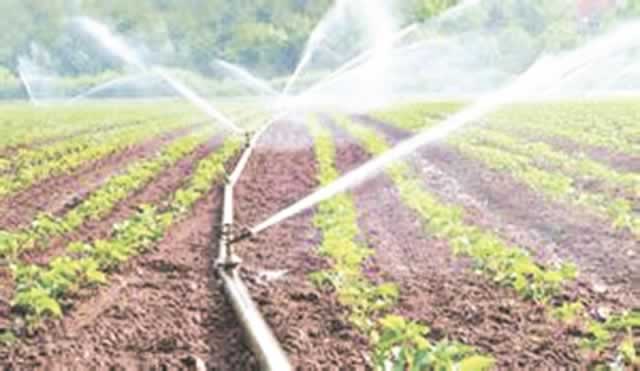Embracing irrigation the way to go

Elita Chikwati Agriculture Focus
For long an abstract concern for a few academics, climate change has since morphed into the thorniest environmental ill of all time, threatening humankind.It is no longer just abstract, but a clear and present danger requiring people to find a new and sustainable path to guarantee survival.
In Zimbabwe, the past few years have seen rainfall patterns vary from season to season, thanks to climate change.
There has been flooding in some areas, while severe droughts have claimed their fair share of responsibility in the suffering of the general populace.
Essentially, these weather variations have impacted negatively on rain-fed agriculture, with dire consequences on food security.
These weather variations and climate change now form the biggest threat to rain-fed agriculture, making it critical for people to switch to irrigation.
Over 75 percent of Zimbabwe’s rural population lives in Natural Regions III, IV and V, where rainfall is erratic and undependable.
This makes rain-fed farming unreliable and risky. The success rate of rain-fed agriculture in Natural Regions IV and V has been observed to be in the order of one good harvest in every four to five years.
This makes it critical for farmers in these dry regions to supplement natural rains with irrigation to boost yields.
Studies on the impact of such investments on smallholder agriculture have shown that producers using irrigation realise significantly higher incomes than those relying on rain-fed agriculture.
With irrigation, smallholder farmers now grow high value crops, both for local and export markets, thus effectively participating in the mainstream economy.
Irrigation also plays a part in the establishment of vital infrastructure such as roads, schools, clinics and telephones, while the farmers have since adopted a commercial mentality.
The 2015 /2016 El-Nino-induced drought saw many farmers in the rural areas losing thousands of cattle.
Some ended up selling their cattle for a song to escape the sad eventuality of watching their cattle succumb to drought.
Besides huge losses in the livestock industry, the country was also importing food, as crops had failed due to drought.
It is against this background that Government has come up with several programmes to boost agricultural productivity by enhancing the irrigation capacity of most farmers that have access to water bodies.
It is Government’s desire to see the country’s farms becoming more productive and cost efficient, with an irrigable expanded maize crop area minimum of at least 300 000 hectares.
Since independence, Government has come up with plans to promote smallholder irrigation as a way of ensuring food security, as well as improving the standard of living of the rural people.
Just recently, Government sourced irrigation equipment from Brazil under the Food for Africa Programme, which is expected to modernise and commercialise smallholder farming and boost household incomes as part of Zim-Asset targets set under the Food Security and Nutrition cluster.
The country has also started receiving the first batch of 80 centre pivots worth over $6 million from Spain to aid irrigation under Command Agriculture, as Government moves to adopt new technologies and strengthen infrastructural development in support of the successful import-substitution programme.
The 80 centre pivots will come in batches of 20 and the first batch is said to be ready for shipment, with installation of the units expected to start next month.
Government views farm mechanisation and automation as key to the attainment of food security.
Already the Tokwe-Mukosi Dam is complete and expected to add some 25 000 hectares of irrigated land with a potential of creating a lot of employment opportunities.
These interventions have, however, been benefiting mostly commercial producers. But with the Command Water Harvesting Programme that has just been adopted, communal and small-scale farmers are set to benefit.
Command Water Harvesting programme will ensure communities in the communal areas are able to produce food even during dry times and guarantee household food security and nutrition while boosting their incomes.
The Command Water Harvesting programme, which is being spearheaded by the Ministry of Environment, Water and Climate, will go a long way in mitigating the effects of drought and also ensure farmers produce cash crops to boost their incomes.
Under the programme, small dams and weirs will be constructed to allow collection of water during the rainy season for use during the dry seasons.
The programme also involves repairing of small community dams, rooftop and rock top rainwater harvesting.
This water will be critical during the dry times.
Command Water Harvesting is a noble idea and will also create employment.
Although the dams will be constructed by Zinwa, communities will also play a role to promote a sense of ownership for the infrastructure.
Members of the community, through their local leadership will identify the strategic areas, where the dams will be built.
They will mobilise resources such as cement, rocks, labour and other materials. This means the community will guard jealously against their resources and maintain the dams.
Siltation has become a major challenge in the country and most dams and rivers are silted.
In essence, Command Water Harvesting is coming in handy, as it will also include de-silting of water bodies.
The new water bodies that are coming on board will also allow people to have sustainable gardens and smallholder irrigation schemes, which will boost income generation and create employment.
Communal farmers are the main food producers and by empowering them, the country will be assured of household and national food security.
Even in drier periods, communal areas will no longer rely food handouts from donors.
Through irrigation, many communal farmers will engage in horticulture, while others may also venture into fisheries and enhanced livestock production projects.
After the Government has done its part, farmers should be responsible by maintaining the water bodies and also practising good agricultural practices.
Government has also introduced the Command Fisheries programme to help communal farmers improve on nutrition.
It is also important that as farmers are empowered to produce crops throughout the year, they are also assisted to secure markets for their produce.
It is disturbing that after hard work, farmers end up selling their produce at give-away prices.
There are instances when agricultural produce flood the markets and farmers end up losing out.
This means there is need for farmers to know the market requirements and to get assistance from extension officers on the best crops to produce at a given time.
Government is also promoting value addition, which should increase the value of agricultural produce.
Instead of farmers selling unprocessed goods, they can take advantage of processing plants that will be established or they can process their produce and sell finished products. This also means more money for the farmers.
It is refreshing that Government is now pushing for the adoption of a deliberate strategy to increase the hectarage under irrigation in all its forms, that is, drip irrigation and centre pivots, among others.








Comments